The November 2016 unemployment report shows continuing distorted monthly unemployment figures. The unemployment rate ticked down by -0.3% to 4.6%, a nine year low, but this isn't the great news as many proclaim. The reason the unemployment rate dropped is yet another almost half a million, 446 thousand more, were considered no longer part of the labor force. Another reason the unemployment rate declined so far is those unemployed dropped by -387,000 and those employed rose by 160,000. Both the labor participation rate and the civilian to employment ratio ticked down a tenth of a percentage point and remain very low. This report sounds like good news on the surface, but it's really just a continuation of the never ending shrinking group of people participating in the labor market.
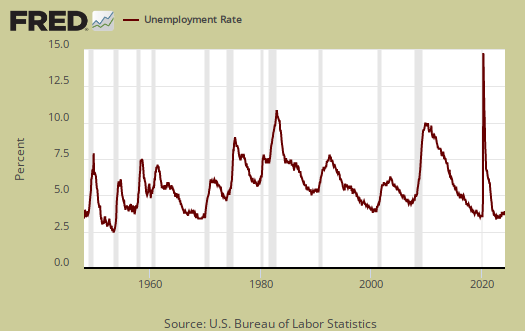
This article overviews and graphs the statistics from the Employment report Household Survey also known as CPS, or current population survey. The CPS survey tells us about people employed, not employed, looking for work and not counted at all. The household survey has large swings on a monthly basis as well as a large margin of sampling error. This part of the employment report is not about actual jobs gained, as reported by businesses, but people and their labor status.
Those employed number 152,085,000, a monthly increase of 160 thousand. From a year ago, the ranks of the employed has increased by 2.641 million. The annual gain has remained approximately this amount for months and is enough to keep up with population growth.
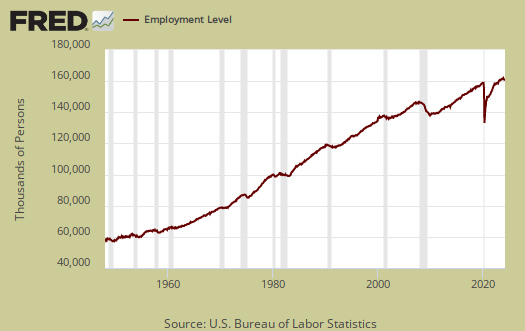
Those unemployed decreased by -387 thousand for the month, a rare, very high monthly figure, yet from other statistics, once again, there is no implication these people all found work. From a year ago the unemployed has decreased by −524,000, which is significant considering how low the ranks of the official unemployed are. Notice almost 75% of the annual drop occurred this month.

Those not in the labor force is 95.055 million, a 446 thousand monthly gain. That's bigger than last month's increase. The below graph are the not in the labor force ranks. Those not in the labor force has increased by 675,000 in the past year. This is so large further analysis needs to be made to determine if these people are retirees or folks who could actually use a job.

The labor participation rate is 62.7%, a -0.1 percentage point decrease Pre-recession, the January 2008 labor participate rate was 66.2% and one must remember the job market was not good pretty much after 9/11.

Below is a graph of the labor participation rate for those between the ages of 25 to 54. The rate is 81.4% and this is a -0.2 percentage point decrease from last month, a very poor sign that the increase in those not in the labor force was due to people dropping out. Ages 25-54 are the prime working years where people are not in retirement or in school full time as commonly as other age groups. In January 2008 the prime working years labor participate rate was 83.3%.

The civilian labor force, which consists of the employed and the officially unemployed, decreased by -226,000 to 159,486,000. The civilian labor force has grown by 2,119,000 over the past year. The BLS counts those on guest worker Visas and even illegal workers mixed in with permanent resident and citizen workers in their statistics.
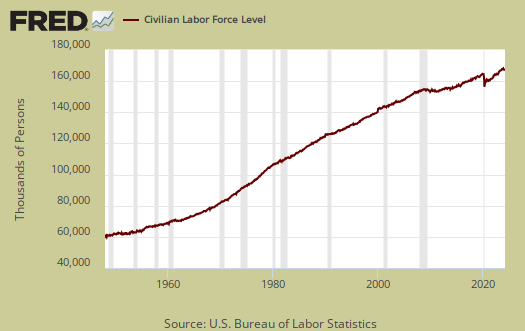
Below is a graph of those not in the labor force, (maroon, scale on the left), against the noninstitutional civilian population (blue, scale on the right). Notice how those not in the labor force crosses the noninstitutional civilian population in growth. The civilian noninstituitonal population is from where all other labor statistics have sprung.
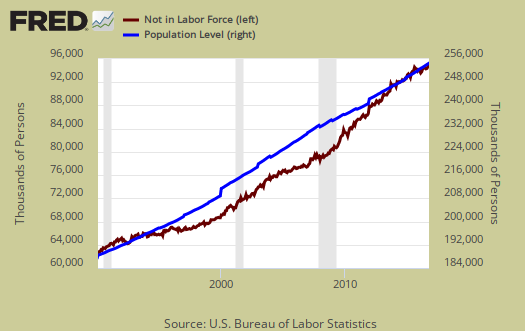
Below is a graph of the civilian labor force, or the official employed plus unemployed, in maroon, scale on left, against those not in the labor force, in blue, scale on right. See how those not in the labor force as a trend exceeded those considered employed and unemployed starting around mid 2009. Starting in 2014 it has reverted back, yet it oscillates starting in 2015. To have a solid employment situation those not in the labor force should be growing less than those obtaining jobs and being counted as looking for work. Those not in the labor force does include retirees and students and there is a baby boomer bump in both of these population groups.
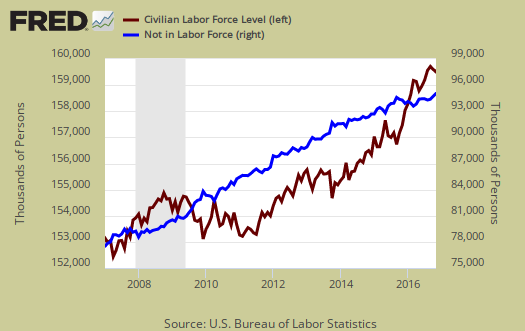
Those considered employed as a ratio to the total Civilian noninstitutional population is 59.7%, which is the same as last month. In January 2008, this figure was 62.9%. The relationship between the employment-population ratio and the labor participation rate (LPR) is: employment-population ratio = LPR * (1 - unemployment rate).
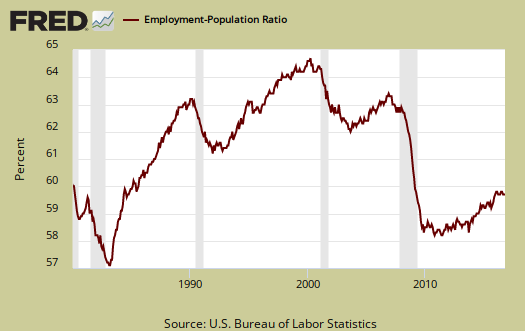
The number of people with part time work gives us some hints as to the kind of work being procured, since most career jobs are full time. Those forced into part time work for economic reasons stands at 5,669,000 people. This is a change of just -220,000 from last month, a very large monthly decline. This monthly drop gives an annual decrease of -416 thousand.
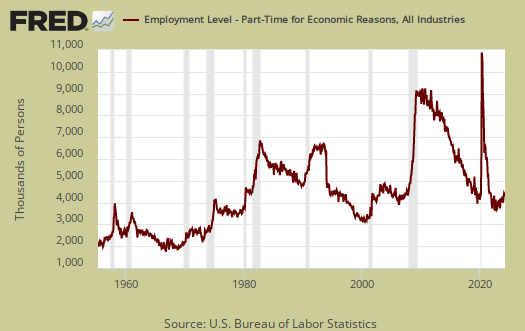
There are two categories of those forced into part-time jobs due to economic circumstances. Those who could only get part-time jobs and those already working who got their hours cut due to businesses not having enough work for them. The number of people who could only get part-time jobs stands at 1,909,000 as shown below. This is a monthly decline of -209 thousand for the month. A year ago, the number of those stuck in part-time jobs was 2,221,000, so an annual decline of -312,000.
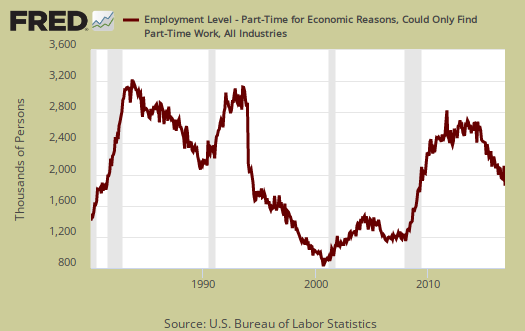
People can also work part-time hours due to slack business demand. People who got their hours cut due to slack working conditions stands at 3,505,000, which is absolutely no change from last month and hard to believe. Below is a graph of forced into part-time work because they got their hours cut, as a percentage of the total employed. This is a recession economic indicator as weak economic demand forces businesses to reduce the working hours of employees.
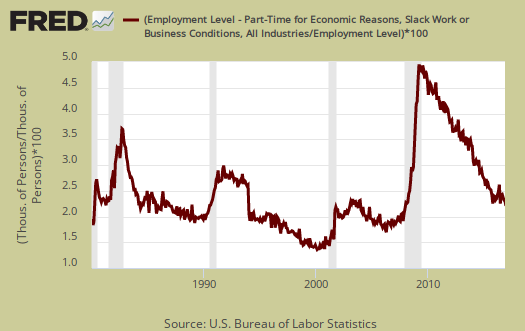
Part-time workers who are voluntarily working part-time jobs stands at 21,018,000, a monthly increase of 327,000. From year ago those working part-time increased by 847,000.
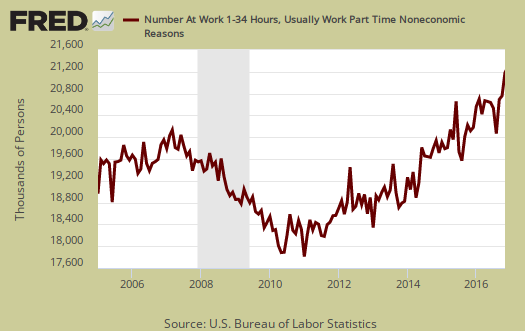
Job losers and those who finished temporary work declined dramatically,by -194,000 to 3,555,000. A year ago, those who were unemployed because they lost a job or their temporary was over numbered 3,873,000.
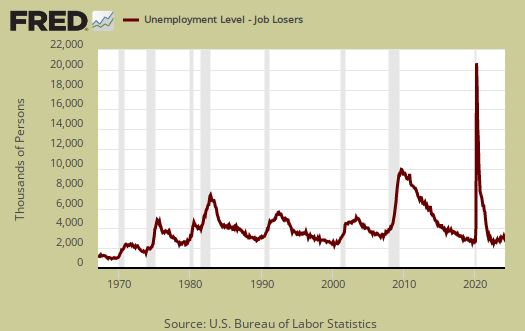
U-6 still stands at 9.3%, which is a -0.2 percentage point decline from last month and the second month in a row for a -0.2 percentage point decline. U-6 is a broader measure of unemployment and includes the official unemployed, people working part-time hours because that's all they can get and a subgroup not counted in the labor force but are available for work and looked in the last 12 months. The U-6 rate still leaves out some people wanting a job who are not considered part of the labor force, so while it is called an alternative rate, but it still ignores many who should be counted as unemployed.
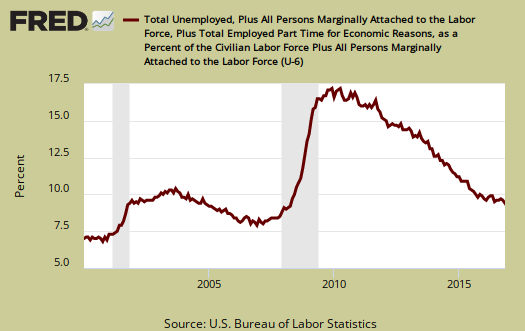
The newly unemployed stands at 2,421,000, a 24 thousand monthly increase. Statistically speaking, BLS CPS data series are independently calculated. Below is a graph of those unemployed for less than five weeks.
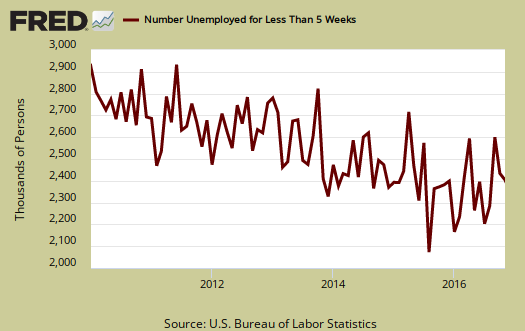
The long term unemployed, or those unemployed for 27 weeks and over, is 1,856,000 people. This is a -123,000 monthly decrease. From a year ago the long term unemployed ranks has declined by -198,000.
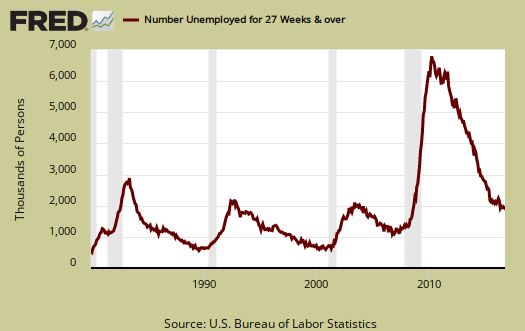
Within the CPS survey is how many people who are considered not in the labor force who report they want a job now. It is a direct survey question. The Census asks people who are not being counted in the unemployment statistics and official unemployment rate if they want a job. The number who answer yes currently stands at 5,876,000. Those not in the labor force who report they want a job has increased by 239 thousand from a year ago. For the month those not considered part of the labor force who said they wanted a job declined by -31 thousand.
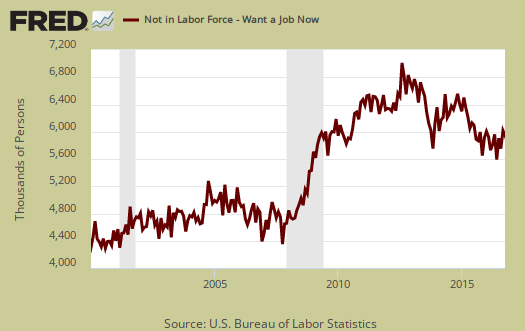
The average length of unemployment is 26.3 weeks, an decrease of 0.9 weeks from last month. The average time to be unemployed has stayed completely out of alignment with the median duration. A year ago the average duration of unemployment was 27.9 weeks.
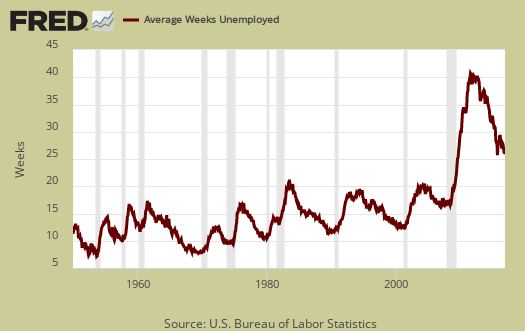
The median time one is unemployed, which means 50% of people have gotten a job in this amount of time is 10.1 weeks, a change of -0.1 weeks from last month. A year ago the median time to be unemployed was 10.7 weeks.
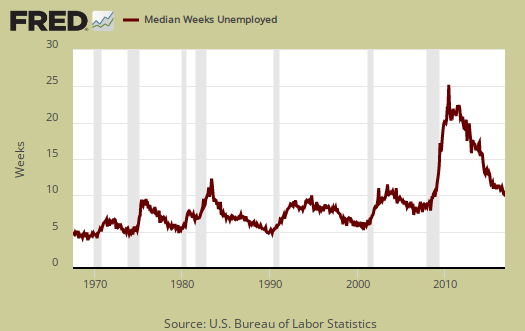
This month's CPS report by itself just isn't impressive. The labor participation rate just is stuck in record lows and nothing seems to budge it, including the rate for those in their prime working years. We expect these statistics to be revised in coming months since so many monthly changes resulted in outlier annual gains and losses Here are our past overviews CPS unemployment statistics, only graphs revised.

Recent comments